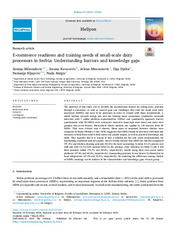Приказ основних података о документу
E-commerce readiness and training needs of small-scale dairy processors in Serbia: Understanding barriers and knowledge gaps
| dc.creator | Miloradović, Zorana | |
| dc.creator | Kovačević, Jovana | |
| dc.creator | Miočionović, Jelena | |
| dc.creator | Đekić, Ilija | |
| dc.creator | Kljajević, Nemanja | |
| dc.creator | Smigić, Nada | |
| dc.date.accessioned | 2024-04-15T20:07:44Z | |
| dc.date.available | 2024-04-15T20:07:44Z | |
| dc.date.issued | 2024 | |
| dc.identifier.issn | 2405-8440 | |
| dc.identifier.uri | https://www.cell.com/heliyon/abstract/S2405-8440(24)03473-X | |
| dc.identifier.uri | http://www.ncbi.nlm.nih.gov/pubmed/38187278 | |
| dc.identifier.uri | https://imagine.imgge.bg.ac.rs/handle/123456789/2343 | |
| dc.description.abstract | The objective of this study was to identify the requirements needed for selling dairy products through e-commerce, as well as current gaps and challenges that exist for small scale dairy processors (SSDPs), and need to be addressed in order to comply with those requirements. A mixed method research design was used for training needs assessment. Qualitative (in-depth interview with 7 online platform representatives (OPRs)) and quantitative approach (survey questionnaire with 58 SSDPs) were conducted. Interview transcripts were coded and codes were grouped into seven themes. Hierarchical cluster analysis was applied to 146 answers from 58 SSDPs. They were divided into 4 clusters. Mean sums of responses between clusters were compared by Mann-Whitney U test. OPRs suggested that SSDPs should be provided with tools and resources to help them achieve food safety and quality targets, as well as practical knowledge and skills. They reported that it is crucial to find a solution for the cold chain transportation, for maintaining consistent product quality. Survey results showed that SSDPs use kitchen equipment (79.3%) and kitchen cleaning products (81.0%) for dairy processing. In total, 43.1% process raw milk and only 24.1% have product label on the package. Only members of cluster 3 and 4 sell their products online (73.7% and 90.0%, respectively), mostly using their own social media platforms (57.9% and 60.0%, respectively), transporting products to end buyers by themselves in hand refrigerators (47.4% and 70.0%, respectively). By analyzing the differences among clusters of SSDPs, trainings can be tailored to the characteristics and knowledge gaps of each group. | |
| dc.language | English | |
| dc.publisher | CellPress | |
| dc.relation | Erasmus+ project “European Excellence in Dairy Learning” (grant number 101055548 — AEDIL-dairy-CoVE) | |
| dc.rights | openAccess | |
| dc.rights.uri | https://creativecommons.org/licenses/by/4.0/ | |
| dc.source | Heliyon | |
| dc.source | HeliyonHeliyon | |
| dc.subject | Covid-19 | |
| dc.subject | e-commerce | |
| dc.subject | Small scale dairy | |
| dc.subject | Training needs assessment | |
| dc.title | E-commerce readiness and training needs of small-scale dairy processors in Serbia: Understanding barriers and knowledge gaps | |
| dc.type | article | en |
| dc.rights.license | BY | |
| dc.citation.issue | 6 | |
| dc.citation.volume | 10 | |
| dc.identifier.doi | 10.1016/j.heliyon.2024.e27442 | |
| dc.identifier.fulltext | https://imagine.imgge.bg.ac.rs/bitstream/id/758910/PIIS240584402403473X.pdf | |
| dc.type.version | publishedVersion |

